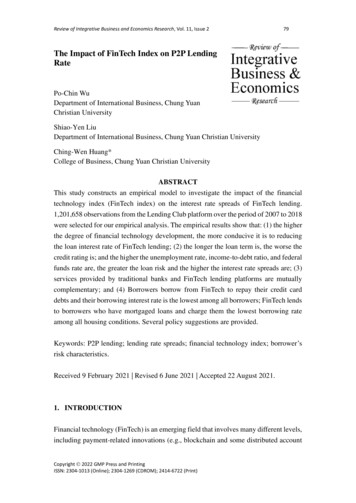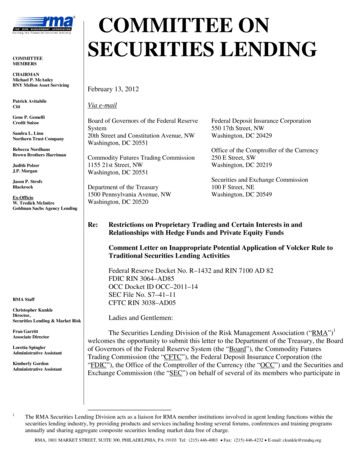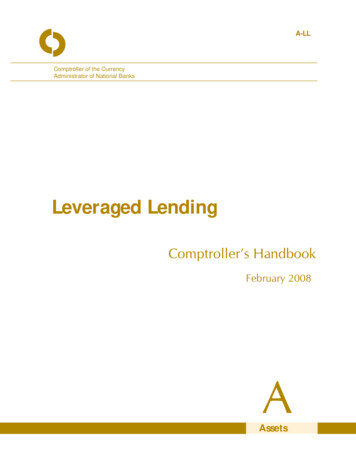
Transcription
2017 ExperianState of LendingWho’s Winning?Community Banks vs. Credit Unions
Community Banks & Credit Unions:By the NumbersWho’s Winning the Lending Game?A look at Key PerformanceHealth Metrics: Growth Profitability RiskWith the explosion of fintech, alternativefinancing and ever-changing consumerbanking behaviors, what does it all meanfor the health and longevity of communitybanks and credit unions? Are they surviving?Thriving? What challenges do they face?In Experian’s latest “State of Lending”we’ll dive into how they are faring as itpertains to growth, profitability and risk,dissecting the key financial ratios, trends andinsights noticed from the past 12 months.But first, let’s set the stage Summary & ConsiderationsAbout this ResearchTo compile these findings, we sourced data on bothbanks and credit unions from the FDIC and NCUA,using S&P Global Market Intelligence. The time-periodassessed includes: The last 12 months (LTM):July 2016 - June 2017 Previous last 12-month (PTM):July 2015 - June 20162
Community Banks and Credit Unions:By the Numbers11,654Total number of community, regionaland national banks, savings and loansand credit unions in the United StatesSince June 2016, this number has declined 4% throughmerger and acquisition activity along with some smallinstitutions closing due to performance. Becausecommunity banks and credit unions view each otheras direct competitors competing for deposits and loangrowth in the communities which they serve, we havefocused this e-book on these two segments only.For community banks and credit unions, the lifebloodof their business is lending. Examples of lendingactivities include Consumer Real Estate (1-4 Family,Multi-Family, HELOC), Agriculture, Automotive (Directand Indirect), Commercial Real Estate, Credit Cards,Personal Loans, Small Business and other loan types.The focus for banks or credit unions often variesbased on the communities they serve, and in the caseof credit unions, the type of charter type they possess.Community BanksCredit Unions# of Institutions5,345; down 1%5,815; down 3%Median Asset Size 188M 31MPercent of institutionsless than 1B92%95%GeographicConcentrationSouth & MidwestSouth & MidwestPercent operatingin one state91%94%PrimaryLending Activities Real Estate (Consumer Mortgage) Real Estate (Consumer Mortgage) Commercial Real Estate Automotive (Indirect, Direct)94Percent of community banksand credit unionswith less than 1B in assets3
Who’s Winning the Lending Game?A Look at Key Performance Metrics
GrowthAssets & GrowthGrowing deposits and loans is how banks and creditunions can stay relevant and compete. For growth,we examined three ratios: deposit growth, loan growthand loans-to-deposits*.Overall, median deposit growth is even for communitybanks and credit unions at 4.1%. The greatestdifference emerges when looking at loans-todeposits. Credit unions are relatively under-deployedat 63%, while community banks are at 81%.When reviewing the growth performance of theseinstitutions by asset size, two key themes emerged:22Percent of responders,according to Experianresearch, who are morelikely to open an offer ifit’s personalized.Lenders should leverage a full suite of prospecting tools.Think mobile, web, direct mail and in-person contact.1Smaller Community Banks andCredit Unions are Losing Ground toLarger Institutions2Credit Unions 1B areOutperforming Community BanksInstitutions with 1B and less in assets reveal loangrowth is a challenge. The median growth for creditunions is 4% vs. 12% for those greater than 1B. Largercommunity banks are also out pacing their smallercounterparts 8.7% vs. 5.3%.Smaller credit unions need help deploying depositsinto revenue-producing loans. They must find moreborrowers to offer the right product at the right time.Credit unions exceed double digits in loan growth, apattern we are seeing both nationally and across eachregion. And unlike the credit unions less than 1B,these credit unions have a healthy loan-to-share ratio.Large community banks are in high single digits forloan growth with slight declines, versus the previousyear. Their loans-to-deposits ratio is over 90%, so theywill need to find more deposits.COMMUNITY BANKSCREDIT UNIONSNationalMedian 1B 1BNationalMedian 1B 1BDeposit Growth4.06%3.82%6.92%4.14%3.88%8.77%Loan Growth5.62%5.30%8.74%4.53%4.09% 12.23%Loan-to-Deposits80.68% 79.62% 90.99% 63.24% 62.03% 86.41%*For credit unions this ratio is loan-to-share but loans-to-deposits is used for simplicity5
ProfitabilityRevenue & ProfitabilityWithout healthy profits, credit unions and communitybanks will be limited in their ability to invest in newtechnology, staff and systems to operate faster anddeliver improved member and customer experiences– all “musts” in this new digital era. So, who’s winningwhen it comes to the profit game? Hands down, it’sthe community banks. Yes, credit unions are nonprofitorganizations, but the ratios here illustrate they haveopportunities to increase their revenue, profitabilityand operational efficiencies.Based on the performance of community banks andcredit unions across all asset sizes, we observed twotrends:1Community Banks are More ProfitableThan Credit UnionsWhether the community bank is less than 1B or over 1B, the median ROAA ratio is much higher than forcredit unions. At 0.32%, credit unions less than 1Bare in trouble. While smaller financial institutionshave been hit hard by the need for regulatoryobligations, the disparity between the credit union andcommunity bank ROAA is worth watching.Return onAverage Assets (ROAA)Efficiency.89%Once again, community banks are winning on thismetric with a lower ratio of 68.5%. For credit unionswith less than 1B, this can be a challenge. While themedian is 85.09%, we have seen some small creditunions exceed over 90% on their efficiency ratios.They are spending nearly every dollar to operate theircredit union, leaving little to invest in improvements.Efficiency ratios reveal how much money a bank or credit union spends to make 1.COMMUNITY BANKSNationalMedian2Community Banks are More Efficient 1B.88% 1B.93%Robust account management strategies includeCREDIT UNIONSNationalMedian.35% 1B.32% 1B.78% Risk Scores Payment History Income Models Total Card Spend Credit Attributes Estimated InterestRate Calculation Segmentation Data68.53% 68.96% 63.87% 85.09% 85.85% 72.68%6
RiskRisk & UnderwritingThe risk pendulum has swung in the world oflending, and it falls largely on the side of taking onminimal risk. The global financial crisis, strengthenedregulations and robust compliance standards havemade many in the financial space risk-averse —credit unions and community banks included.The average loan yield for smaller credit unions isthe highest of all types, as more are testing lendingdeeper to reach beyond the prime borrower. Whilesome are taking on more risk, risk-averse lendingpractices are still the norm. Net charge-offs forcommunity banks and credit unions are flat ordeclining from the previous year.COMMUNITY BANKSNationalMedianLoan Yield 1B 1BCREDIT UNIONSNationalMedian 1B 1B4.08%4.10%3.90%5.23%5.30%4.16%Non-Performing Loans(Delinquencies).89%.89%.90%.69%.71%.43%Net Charge-Offs.05%.05%.05%.35%.34%.38%Net Charge-Offs are 7x HigherAmong Credit UnionsFor accounts that have fallen into collections,lenders should consider digital outreach.Regardless of asset size, credit unions appear to betaking on greater risk, and as a result are writing off ahigher number of loans.1 in 3 people prefer to deal with debt online.22Experian Survey, September 20157
In SummaryObservationsFor those with lower revenues and profitability,increasing the average loan yield can be a route tosuccess. For banks and credit unions, money is madeon the spreads. If most loans are being issued toprime borrowers, there will be lower margins, giventhe competition for these low-risk consumers is high.These individuals can expect low rates. By lendingdeeper to near-prime and sub-prime borrowers,the rates that community banks and credit unionscan command is much higher. Some institutions areembracing this opportunity to differentiate and servea greater population of their communities.TipCouple trended data with a solutionlike Credit3D, which bundles propensityscores, profitability models andtrended attributes, and now lendershave a solution that truly unveilsthe value of trended data insights.12Utilize Data to Make Smart Risk DecisionsTest and control groups are essential to continuedimprovement of your targeting strategies. Newhypotheses can be evaluated through test populationsor small groups designed to identify new opportunities.Let’s say you typically target consumers in a riskrange of 650-720, but an analyst spots an opportunity.Consumers, with a range of 625-649 with nodelinquencies in the past 12 months, perform nearly atthe rate of the current population. A small test groupcould be included in the next campaign and studied tosee if it should be expanded in future campaigns.Consider Trended DataIt is important to remember that credit scores are asnapshot of a moment in time. It only tells part of thestory. Trended data can help assess a consumer’scredit behavior over time, helping lenders determineif that consumer score is trending up or down.Understanding how a consumer uses credit or paysback debt over time can help lenders: Offer the right products and terms to increaseresponse rates Prevent attrition Identify profitable customers Avoid consumers with payment stress8
“How do [banks of the future] makemoney? The answer is, by being themost intimate provider of service tothe customer based on that digitalfootprint, and by being able to reallyleverage our understanding of thecustomer’s financial lifestyle far betterthan any other player.”2With the economy still healthy – all key indicators pointto a solid 2017 close – the story for community banksand credit unions has largely been one of growth. Still,with the competitive pressures of fintech players, creditunions and community banks must find ways to investin technology, advance their data and analytics prowessand market, decision and acquire smarter.Are you interested in seeing how your financialinstitution measures up to the competition?Contact your Experian account executiveor visit banking.html9
Experian475 Anton Blvd.Costa Mesa, CA 92626T: 1 888 414 1120www.experian.com 2017 Experian Information Solutions, Inc. All rights reservedExperian and the Experian marks used herein are trademarks or registered trademarks of Experian InformationSolutions, Inc. Other product and company names mentioned herein are the property of their respective owners.
Personal Loans, Small Business and other loan types. The focus for banks or credit unions often varies based on the communities they serve, and in the case of credit unions, the type of charter type they possess. Community Banks and Credit Unions: By the Numbers Community Banks Credit Unions Percent of community banks and credit unions











